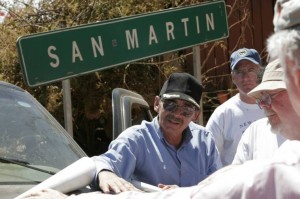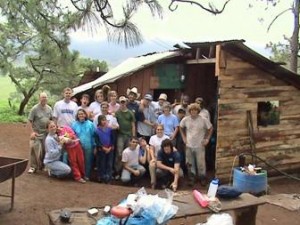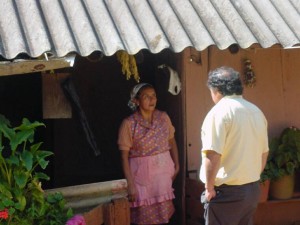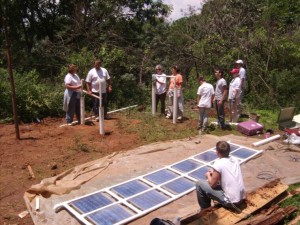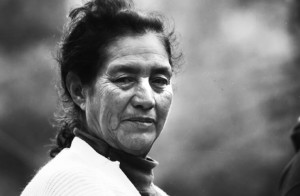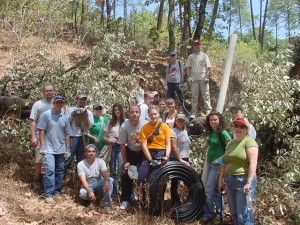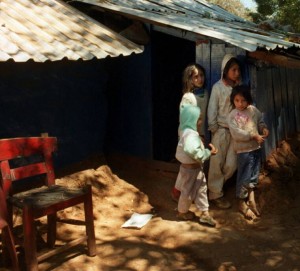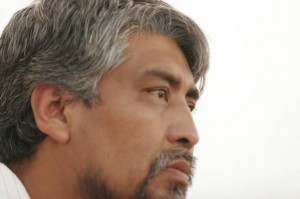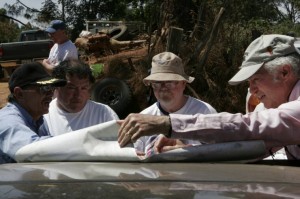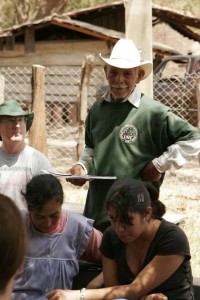University North Texas Dallas- Power Point on Garden Project
More information on Forming a Chapter
Building Small Sustainable Villages: A Case Study by S. Ingman, T. Benjamin, S. Flores, Eduardo Contreras
Introduction
In 2002, we initiated contact with the village of San Martin in the State of Jalisco, Mexico. This account will trace the history of our partnership with landless farm workers or squatters, and their attempts to secure a higher quality of life. Access to water and electricity were the primary stated needs identified by the residents. Residents had to walk one mile or so to secure a bucket of water. They had no access to the electric grid or any other alternative source of electricity. Many have lived in this village or plot of land for over 25 years. Many had worked for the landowner as farm laborers all their lives. Given the lack of property rights, the village of San Martin with its ten families is similar in structure to a feudal estate that was common in Europe in the Middle Ages. Because of the very rudimentary houses on the hillside next to the dirt road, It is somewhat startling to notice an official federal road sign announcing the village of San Martin.
Our simple model of sustainable development was to focus upon four issues and in general was the guide for our partnership with San Martin: improving their economic well-being , improving their social and physical environment , their education for sustainability and finally to increase their empowerment to manage their own affairs. We will evaluate how well our model guided our 7 years of involvement with the families of San Martin.( Ekstrom, Ingman, 2000) Until now we have had limited impact upon their economic well-being.
Building a Partnership- Initial Intervention
The University of North Texas Center for US/Mexico Alliance for Community Development and the non profit organization , Future Without Poverty, Inc. ( www.fwop.org) , undertook sustainable development projects in the region near Mazamitla, Mexico in 2000. Field Schools from the Study Abroad at UNT was the initial mechanism to assist villages and households in the region. Our first visit to San Martin was in 2002.
After sitting down with the families in San Martin was determined that the first step was to establish confidence between partners. Creating one successful project is a crucial first step. Access to minimal power to have lights at night was the initial priority. From a donor in Texas we acquired a gasoline generator for some $1700 in Denton Texas which was then transported to San Martin. A small shed some 46 feet square feet was built by the village residents to house the generator. The mayor of Mazamitla, the major city in the region,
had promised to wire the village. The gasoline generator remained in the packing crate for some months with no action. So, when students from North Texas arrived on a field school, wire was acquired and put through the trees to each home and in a day or so the village had electricity. Each home had one or two light bulbs to light their homes in the evening. A committee for management was established to collect funds to buy gasoline and manage the system. When someone fails to pay their contribution and the committee feels they can truly pay their share, access to the system is denied and the electric line is disconnected to their home. This occurred in at least one case.
In summer of 2008, as the generator aged and less reliable, volunteers from Virginia installed three 70- watt solar panels to replace the generator. A friend of FWOP sold us a $20,000 solar system for $2,.500 which had eight 70 watt solar panels . Thus, the residents were able to eliminate the use of some gasoline, and the generator became a backup system when the solar panels failed to provide sufficient electricity for residents.
The use of the solar panels with a battery storage system reduced both the daily cost of the electricity and the environmental impact of utilizing fossil fuels. This became a cost effective environmentally sustainable solution to providing electrical service to this small village.
The Water Access Crisis in San Martin
A story about an experience in 2004 that Tom Benjamin had in San Martin indicates why we began to focus upon access to water:
“A tear and a plea for help changed what poverty really meant to me that one hot summer day in San Martin. I was told that this mountain top community did not have any water and that the local mayor had promised to bring water to the community for the past 18 years. The older woman that I was introduced to earlier that day was carrying a five gallon plastic bucket and was slowly making her way through the brush up the side of the mountain. I asked if she could show me where she was going to get water.
She agreed and we began our journey up the mountain down the mountain up over another mountain and down to what was an almost dry hole in the ground where the cattle were drinking. She scooped out the floating stuff on top of the water and filled her bucket. She told me she did this twice a day to water her flowers and to give her the water she needed. We had walked about a mile and I was tired and now she was carrying about 4 gallons of water in her bucket back to her home. The water and bucket weighed about 35 pounds and it seemed a lot heavier as I helped carry it back.
When we had walked a little ways we stopped and I asked her if this is where she goes to get water all the time. She then told me that no this is where I go during the wet season when it is dry I have to go much farther. Then she began to cry and I did not understand what I had done to make her cry. She explained to me that she was 86 years old and if she could not go get water during the dry season that she would probably die this dry season.
I realized that being poor reduces your options but now I saw first hand that being poor could also be a life sentence of hard work and possibly a death sentence. At that time I told her that I would have running water at her house before the dry season started this year. I did not know how I was going to do it but I knew that I have done it in many other places around the world and I sure was going to do it here. So starts the story of bringing water to San Martin.
Creating a Low Cost Water Access
Since digging wells is an expensive venture we worked to locate an alternative system. We learned about various springs some two to three miles away from San Martin where residents walked to pick up buckets of water. We located one spring some two miles away from San Martin that had a constant flow even at the end to dry season. Using GPS we determined that the spring was some 175 feet higher than San Martin. Thus, by dropping the water from a cistern in a ravine where the spring flowed down the hill we could have enough gravity pressure to push the water up a road to San Martin to another cistern for the village to secure buckets of water in the village. Rotary Clubs in Denton and in Gainesville provided $3000 for pipes and two cisterns . Students from UNT on a field school installed the two cisterns and laid and buried the plastic pipe in May of 2006 just before the rainy season and after several days water flowed to San Martin from two miles away.
In 2007, volunteers from Grace United Methodist Church from Manassas, Virginia worked for one week in San Martin to lay pipes to each home with a single faucet either inside the home or just outside the home. After one week each home had access to running water. Virginias’ Methodist contributed $500 to buy the pipes, faucets and supplies to make the system work.
In 2008, our partners from Virginia returned to the site to build a community bath house with two toilets, a shower, and a room for clothes washing. They also built a septic system for the toilet water and a barrel to collect gray water from shower and washroom for drip irrigating a mini kitchen garden. Rotary Clubs of Denton and Gainesville provided some $10,000 for the supplies, e.g., toilets, wash basin, shower head, cement, roofing material .A small chicken cage and an extra storage room for a single elder’s home were also built during the trip. Rains prevented the team from Virginia and FWOP to work every day on the bath house project as planned . Furthermore conflicts with the landowner developed and so the project took some 15 months to complete. Additional local labor was brought in to complete the project finally. We will discuss some of the political issues that arose below.
The Surprises of Community Development
In the first months of our involvement a major crisis developed in San Martin. A mother became mentally ill and ran off her seven children and her husband. The residents quickly built a two-room shed 15 feet by 30 feet to house the father and the children. For the while the father, two boys and five girls age 5 to 17 stayed in the shed. Some months later the father moved back with his wife and left the children on their own.
Various minor interventions were undertaken to improve the life of the seven children. Bulk food was secured from the welfare department of Mazamitla. Graduate social work students from Texas worked with the children for some two years and managed to secure a visit from a social worker from the State of Jalisco. These social workers succeeded in obtaining a cell phone for them to call for Mazamitla police, 20 minutes away, for help. The mother occasionally would come to the dwelling to abuse the children. Subsequently, the police would arrest her and put her in jail for a few days. Others insulated the house to prevent the cold mountain air from penetrating, for San Martin is some 7500 feet above sea level.
Over the course of some two years we added two lights bulbs and a pipe to bring water to their home. We started a fund to subsidize their contribution to the gasoline fund to support the running of the generator. The shower -toilet room was put in downhill side of the house and a mini three sided kitchen was built near the front door so that they could cook their food when it rained. The proposed shower was quickly turned into a storage area. The older boy and older girls continue to work in the fields to earn money to survive. None of the children attend school. However, the landowner has deeded the land to the seven children.
Landowner Relationship
As we arrived in San Martin we learned about landownership issues. We were told that most land in the region was owned by three landowners and most residents were squatters. The owner of the land where San Martin was located expressed his interest in our efforts for these landless farm laborers and complained that Mazamitla had not helped ‘these” people in some 26 years. Most working age men, women, boys and girls worked for the landowner when there was work on his farm.
As we started to solve the water access issue the water access issue the landowner’s interest was whetted. At first he was not supportive. When he learned that Mexican law forbid denying access to water was against the law, he changed his mind. Various landowners had tried various schemes to create better access to water from springs but had failed to create a reliable source of running water from any springs to irrigate their fields.
The work we did to improve the lives for the seven children received his support. He decided to provide them with ownership of the small plot of land where their shed stood and discussed giving the others all land rights to their land. The ten families now have 99 year leases for the land where their houses sit.
To illustrate the complexity of working with feudal estate situations, an incident is worth recounting. When we got the water system operational, unbeknown to us, the landowner asked one person to cut the water line coming to San Martin from the spring some two miles away. This person cut the line as ordered, but not entirely. He then told another resident where it would be cut the line , and this person quickly repaired the line with tape. This process of cutting and repairing the line occurred several times. The first person merely cut the line partially so the pressure in the line would not be lost.
Later on, when a few people started to move to San Martin he became concerned. With access to running water and electricity, other landless laborers decided San Martin looked like a pretty good option. The bath house project caused a conflict with the owner. His sons gave permission. As we built the bath house their father, the owner of the land, told us to stop and destroy the bath house. Finally after many months of negotiations, our staff had to repair his road before he would give us permission to continue and to complete the bath house.
Community Empowerment
“The act of empowerment implies developing capacity for some degree of control over actions and events that have an impact on the personal or collective well-being “ ( Ekstrom, Ingman, 2000) .The initial indication that residents had some power to determine their own fate was observed when we learned that the men built a shed or house for the seven children on their own. Next, the village committee for managing the collection of funds to pay for the gasoline for the electric generator was done with little fanfare.
The residents depend upon the good will of the landowner so they must be careful not to alienate this family, so there are limits to how aggressive they can become. When others started to move into the village and build new homes the landowner became nervous. This was seen as an unintended consequence to community improvements.
The landowner initially said he was happy to see us partner up with residents to improve the lives of “his” squatters and “his” farm workers that assisted him week after week. He complained that the regional government had done little for the residents in San Martin. San Martin as a village is very close to a feudal estate. Any plans requiring the cooperation of the local population had to be elaborated cautiously so as not to alienate the landowner. The bathhouse project was first approved and then the patriarch decreed that he did not want to have it built, even if it was half built. His two sons had given us permission to build. Slowly we discussed the project further and the sons spoke to their father. Finally we agreed to repair a section of the father’s drive way and in return we could complete the bath house.
Creating a Community Development Team
First it must be made clear that most of our team lives in the United States. Syl Flores as a Spanish speaker was the team leader and located the
village and negotiated with the residents and the landowner to begin the partnership. Tom Benjamin was our engineer for designing the various systems we installed in San Martin and was in charge of the field schools and the church group who volunteered in San Martin. Stan Ingman was a support person who worked on fund raising with Rotary Clubs. Eduardo Contreras was a resident of Mazamitla who was on the staff of Future Without Poverty, Inc. and did much of the negotiation with the residents and the landowner in last several years to complete the bath house project and solar panel installation. He has become the major local team leader for Future Without Poverty in San Martin and for other village projects in the region. Mr Contreras has become knowledgeable now in accessing spring water, solar power installation, chicken/farm installations, establishing textile cooperatives, and the many skill of community development that are needed the politically complex region of Mazamilta.
Conclusion:
After some seven years of involvement we have learned much about building more sustainable communities for the working poor in Mexico. We did not make revolutionary changes in the lives of these residents. However, we were able to improve the quality of life in two significant ways: access to clean running water and low cost access to electricity. We achieved both without inflicting any major damage to the ecosystem near San Martin.
Empowerment of residents to manage their own lives and make improvements was not major but also not insignificant. The control of the fund for the gasoline and the ability to deny access to the electric power is the best evidence that the community could unite to control their own environment. Earlier on we had the example of the residents building the shed or home for the seven children alone as we first arrived in the community. Our most long lasting impact could be on the issue of land ownership. The fact that all residents now have a 99-year lease to the land where their home sits is a major long term impact of out intervention and partnership.
One lesson of our involvement in San Martin is that mini successes breed bigger successes both in San Martin as well as in other villages in the region. Similar efforts in Flor de Campo, where we started with others with introducing electric grid power, a small textile cooperative , built a bridge and created a chicken/fish farm , were stimulated by the San Martin success.
The authors of Ecology of Hope write about the need to restore both culture and ecosystems… to get something done. (Bernard and Young, 1997). These authors relate various accounts of the importance of success stories in inspiring others to improve their communities. The gravity water system was the most dramatic reputation building effort. Many people had tried to locate and access spring water and failed in the region. Many people came by to learn about the San Martin project and ask for assistance to carry out a similar project near their village. (Roseland, 1998)
One major function of our work in San Martin related to the teaching of students in a service learning mode (Stanton, Giles, Cruz, 1999). Students from Turkey, Ethiopia, Mexico and USA all learned how small changes could be realized with little funding in a third world situation. In terms of education, we had created a local trained community development expert in Eduardo Contreras. This is one major long term impact of our involvement in the region. (Newman, 1998) The” myth of no effect” was broken, or the notion that change is impossible in extremely poor situation was challenged. ( www.fwop.org) .
Reference
T. Bernard and J. Young The Ecology of Hope: Communities for Sustainability East Haven, CT: New Society Publishers, 1997.
T. K. Stanton, D. E. Giles , and N. I. Cruz ( 1999) Service- learning: A movement’s pioneers reflect on its origins, practice and future, San Francisco: Jossey-Bass.
M. Roseland Toward Sustainable Communities: Resources for Citizens and their Govenments. Gabriola Island BC , Canada, New Society Press, 1998.
G. Newman “ Students Stimulate Community Development Planning in Guzman, Mexico” Sustainable Communities Review , Fall 1998 Vol 2, No 2, pp 17- 22.
C .Ekstrom and S Ingman “Community Empowerment and Sustainability “ Sustainable Communities Review F all/Winter 2000, Vol 4, No 1, pp8- 12
